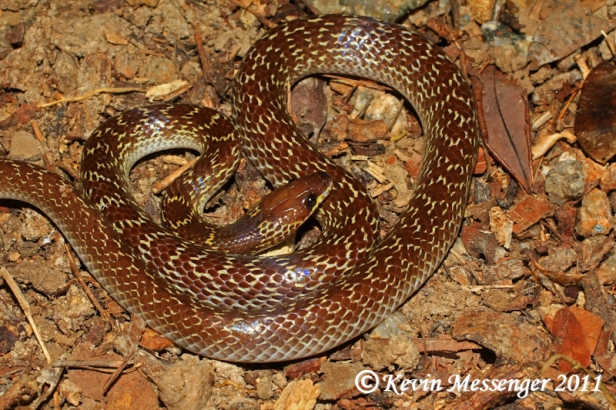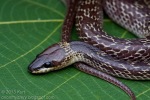Lycodon capucinus

English name: Common Wolf Snake (aka: “Common House Snake”, “House Wolf Snake”)
Scientific name: Lycodon capucinus
Thai name: Ngu Soi-luan
Description: To 76cm long. A small snake of average girth. Head is somewhat flattened. Body is brown to brownish purple with very indistinct pale to yellowish bands that sometimes meld together into reticulations of brown, white, and yellow. Head is brown with pale yellow lips and a pale yellow collar around the neck. Underbelly is whitish to yellow.
Similar Species: Sunbeam Snake also has a white collar as a juvenile, but lacks markings on the rest of the body and has strongly iridescent scales.
Common Bridle Snake is more slender and vertically compressed with more distinct white blotches.
Banded Krait has very distinct, broad dark and light bands and a triangular-shaped body.
Habitat: Naturally found in forest, but has become common in urban areas near small pockets of trees. The Common Wolf Snake is often found inside homes, where it preys on geckos and small rodents. It is semi-arboreal and can be seen climbing walls at night.
Contribution to the ecosystem: The Common Wolf Snake mostly eats geckos and skinks. It also feeds on frogs, small mice and baby rats in the home. This snake is eaten by larger snakes and monitors.
Danger to humans: This small snake is completely harmless to humans.
Conservation status and threats: No known conservation threats. The Common Wolf Snake was recently found to have colonized Christmas Island in the Indian Ocean, where it is negatively impacting local skink populations and is regarded as an invasive species.
Interesting facts: The Common Wolf Snake has a number of special adaptations in its teeth that may help it to swallow hard-bodied, smooth prey like skinks. These include enlarged front teeth to help encircle the skink and prevent it from getting out of the mouth, short spatulate middle teeth to help catch under the skink’s scales, and long blade-like rear teeth to slice through the hard scales of the skink.
References:
Ecology Asia: Common House Snake
Dentitional specialisations for durophagy in the Common Wolf snake, Lycodon aulicus capucinus
A Photographic Guide to Snakes and Other Reptiles of Peninsular Malaysia, Singapore and Thailand
A Field Guide to the Snakes of South Vietnam
A Field Guide to the Reptiles of South-East Asia









what is the effect of poision of this snake .
why this protect to peoples..??
This snake has no venom or poison. It can bite and draw a little bit of blood, but the bite is otherwise harmless to humans.
Does this snake shake its tail like a rattlesnake might do and make striking or fast jerking movements as if to bite?
Yes, it does both those things.
I haven’t seen the tail-shaking behavior myself, but I have read it exists. The reason is not to mimic rattlesnakes (obviously, no rattlesnakes in Asia), but most likely to confuse the predator with excess movement, and possibly to divert the predator’s attention to the less-vulnerable end of the body.
And yeah, in my experience wolf snakes demonstrate a lot of fast jerky strikes that don’t actually reach the target. They are trying to scare the predator away – they’ll employ a bite if necessary, but with any true predator the nonvenemous bite itself probably won’t cause enough harm to matter, so trying to frighten the predator with strikes is more important than actually hurting it with a bite. Also, a bite on a large predator could cause teeth or mouth damage and attaches the snake to its predator, making it harder for the snake to get away quickly.